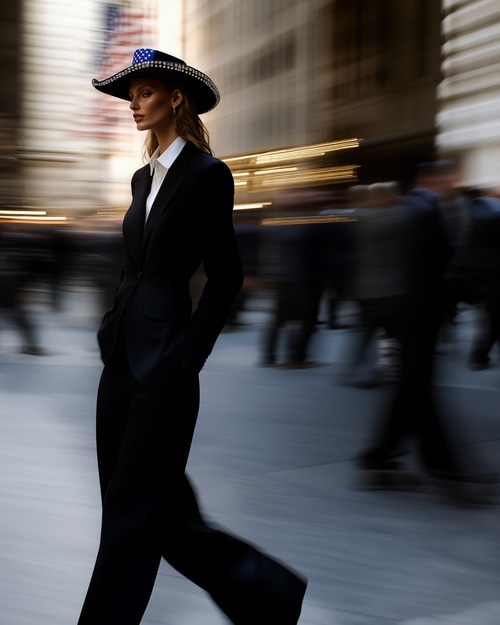

Why Thailand Is Luxury’s Next Big Bet
Thailand has been popping up on our cultural radars more and more lately. And it’s not just the new season of White Lotus - although Hotels.com has reported a 40% spike in searches for the Four Seasons Koh Samui, one of season three’s filming locations. Looking at the wider world of luxury, we’ve been seeing brands pay more and more attention to South-East Asia’s second-largest economy.
Between 2023 and 2024, the number of Thai celebrities attending Fashion Weeks across the world increased 225%. And major labels like Prada, Balenciaga and Gucci have taken on Thai celebrities Metawin “Win” Opas-iamkajorn, Krit Amnuaydechkorn and Davika “Mai” Hoorne as ambassadors respectively.
Why are luxury brands increasingly drawn to Thailand? What’s the opportunity we’re seeing here today and importantly, what does that look like tomorrow?
First, Thailand is home to a growing luxury audience. This growth can be observed at both the UHNW end, with Knight Frank projecting those with assets over $30 million to increase 14.7% by 2028; and within the urban middle class, as the economy grows and brings with it socially driven, digital-first Millennial and Gen Z consumers, who enter the category at a younger age and look to luxury as a means for self-reward.
Second, Thailand has been an increasingly important destination for luxury tourist spend since the pandemic. Drawing visitors from established luxury markets in the region, such as China Mainland, Hong Kong, South Korea and Singapore, Thailand has tourists to thank for 40% of its luxury consumption. And while the country has long attracted resort tourism to its islands and beaches, the opening of Thailand’s first Ritz-Carlton and Aman’s latest outpost in Bangkok both indicate that UHNW travellers are being drawn to the cities too. Indeed, the capital is a driving force for art, design and fashion in the region, boasting a thriving contemporary arts scene and home to burgeoning streetwear movements and local brands and designers like SRETSIS, Ravipa and Pipatchara. Thailand is firmly on the track to becoming a true destination for luxury.
In fact, we can expect Thailand to surpass Singapore as the dominant luxury player in South-East Asia by 2028. On the ground, nowhere is Thailand’s growing importance more apparent than One Bangkok. A mix of luxury retail, hotels, residency and office space, the $3.9billion development is due to open fully in 2026 and had already leased over 80% of its retail space as of last year. The development includes Bangkok’s aforementioned first Ritz-Carlton, while to the north, Loro Piana has opened its doors for the first time in the country, with Louis Vuitton’s first South-East Asia restaurant down the road at LV The Place.
As many luxury brands pay real attention to Thailand (and Bangkok especially) for the first time, this is just the beginning of the country’s growing place within luxury. For brands looking to unlock the opportunity with both local consumers and travel shoppers, retail will be key. It’s usual for travel spend to be centred in physical stores; a strong mall culture in Thailand makes retail important for the local audience too.
And when you’re rubbing shoulders with direct competition in sprawling malls and shopping districts, you need to draw attention through visual impact and one-of-a-kind spaces and experiences. Dior’s Gold House is a great example of this. Lavish, ostentatious and vast, its glittering facade stands out easily in Bangkok’s Ploenchit district (and is a far cry from the elegant and restrained Parisian flagship 30 Montaigne). Meanwhile, a lush garden walkway into the house, Café Dior inside, and the incorporation of works by Thai artists turn the retail space into a unique brand experience.
Today, luxury players are primarily drawn to Thailand for its increasing economic clout. We also see a future for the nation as a cultural powerhouse.
Arguably the best-known example of Thailand’s growing cultural power is Lisa. Though she originally debuted with K-pop group BLACKPINK, the singer, rapper and dancer’s career has since extended to solo releases and of course, most recently, moved into acting in White Lotus. In recent years, she’s increasingly put her Thai heritage front and centre, and as a global superstar, this means bringing worldwide attention to Thailand. The music video for “Rockstar” sets lyrics about being a global star against scenes in the streets of Bangkok; and in her video for “LALISA”, she platforms local designer Polpat Asavaprapha in a modern twist on the traditional sabai breast covering and zin sarong wrap.
And Lisa is not the only example of Thailand’s growing soft power. Amongst the country’s immediate neighbours, across markets like China, Singapore and Malaysia, intense fandoms are building around Thai films and dramas. The boys’ love (BL) genre has been particularly successful in the region. Depicting love stories between men but for the straight female gaze, these shows offer women a chance to lose themselves in romance, outside of the unequal gender dynamics that plague hetero relationships. The genre has been criticised for fetishising gay love, and what sets Thai BL apart are moves towards more genuine and nuanced representation.
The drama KinnPorsche is one example, portraying its two male leads with depth and complexity, and showing the true emotional connection between them. The show also tackles the challenges that gay men can face, depicting both characters’ journeys to accepting themselves and their sexuality, all in the context of societal and familial expectations. Off screen too, lead actors Nattawin “Apo” Wattanagitiphat and Phakphum “Mile” Romsaithong are vocal supporters of queer rights. It’s no coincidence that Dior has signed both actors as brand ambassadors.
But perhaps most interesting of all is that Thailand’s cultural exports are beginning to make waves across the globe. Spotify announced in 2023 that T-pop streams had doubled in just a year, with Thai artists finding fans in places like the US, Sweden, Mexico, Germany and France. Meanwhile, Thai Netflix series Master of the House became the first Thai production to top the weekly charts for Global Non-English series last year.
None of this has happened by accident. The Thai government has been transparent about its soft power ambitions, supporting eleven key industries that include music, books, gaming, art, design and fashion. In fact, plans were being made to film White Lotus 3 in Japan, when the Thai government renewed a film incentive system that ultimately allowed the White Lotus team to claim $4.4 million in tax rebates. The growing global appeal and influence of Thai pop culture has been dubbed the ‘T-wave’, drawing parallels to the Korean wave and the ability of K-drama and K-pop to transcend borders and find fans across the world.
Just as luxury has been tapping into the Korean wave to drive cultural resonance in South Korea, Asia and much further afield, the T-wave may be the next cultural phenomenon that unlocks global influence for brands. The speed with which luxury labels have snapped up Thai celebrities as brand ambassadors demonstrates wide recognition of the market as a growing economic powerhouse - luxury brands will increasingly need to treat Thailand as a growing cultural powerhouse too.
One way would be to move from signing Thai celebrities as brand ambassadors, towards engaging them as co-creators. Lisa has acted as brand ambassador for Bvlgari since 2020; in the last two years, the brand has moved into more of a creative partnership with her, releasing limited edition Bvlgari X Lisa timepieces. Like this, brands can demonstrate deeper, more genuine engagement with Thai pop culture, by recognising the creativity, artistry and tastemaking power of their ambassadors.
As the worldwide interest in Thai culture grows, brands might also look to play a role in platforming new and emergent talent. One example from the world of K-pop is Acne Studios’ partnership with girl group ILLIT - before the group had even released any music. By launching their S/S 2024 collection with ILLIT around two weeks before their first single, Acne Studios effectively ‘soft launched’ the group, thus positioning the brand as a cultural leader with an instinct for what’s next.
Indeed, many luxury labels are increasingly looking to build cultural leadership, acting as stewards, patrons and forces of influence in the wider world of arts and media. Saint Laurent Productions represents major moves in this direction, producing Emilia Pérez in 2024, which has proven a magnet for both awards and controversy. For brands truly looking to make inroads in Thailand and tap into the burgeoning global influence of the T-wave, they might consider their role in constructively and respectfully driving Thai pop culture forwards - through production and other creative support and involvement with local film, music and so on. If Dior is listening, fans are begging to see Apo and Mile reunite again in another BL pairing.
All in all, Thailand no doubt offers exciting prospects for its economic potential. We’re equally (if not more) excited by its future as a leading cultural force around the world. There’s plenty here for luxury brands to pay attention to - and those that tap into the T-wave authentically and constructively can drive connection, excitement and influence with both the nation’s growing luxury audience and far beyond.


